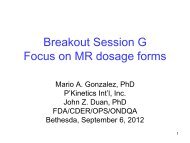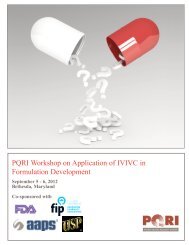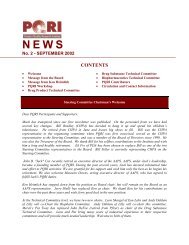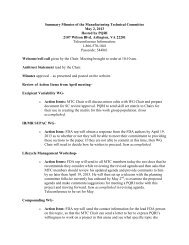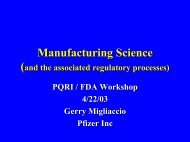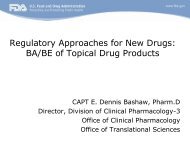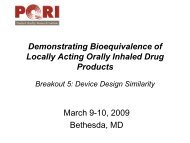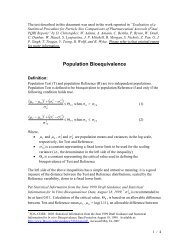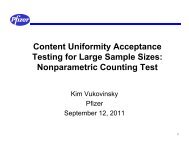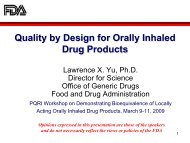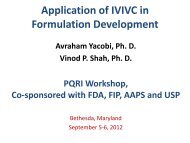Determination of Water Vapor Transmission Rate for High ... - PQRI
Determination of Water Vapor Transmission Rate for High ... - PQRI
Determination of Water Vapor Transmission Rate for High ... - PQRI
Create successful ePaper yourself
Turn your PDF publications into a flip-book with our unique Google optimized e-Paper software.
Data in the literature shows that the relative humidity in air dried by anhydrous calcium<br />
chloride is 1.6% at 25°C i . Literature also indicates that calcium chloride can exist in<br />
multiple hydrates, and that the hexahydrate loses water at 200°C ii . This in<strong>for</strong>mation on<br />
hydrates shows that the activation temperature must be higher than 200°C if the desiccant<br />
has been previous exposed to humidity and <strong>for</strong>med hexahydrate. The history <strong>of</strong> the<br />
desiccant must be considered because during shipping, storage, and use the anhydrous<br />
calcium chloride may be exposed to moisture at some points, hence care must be taken to<br />
activate the material properly be<strong>for</strong>e use.<br />
A preliminary experiment was conducted by a member laboratory to select the activation<br />
temperature <strong>for</strong> anhydrous calcium chloride after the material was equilibrated at<br />
6.4%RH at room temperature. Activation was conducted by heating at 110°C and 210°C.<br />
Results showed that loss on drying was 0.5% and 4.5% by activation at 110°C and<br />
210°C, respectively. These results showed that activation <strong>of</strong> anhydrous calcium chloride<br />
at 210°C is necessary to fully activate the desiccant even if the material has been exposed<br />
to an environment <strong>of</strong> extremely low humidity.<br />
To estimate the quantity <strong>of</strong> anhydrous calcium chloride needed to maintain a sink<br />
condition <strong>for</strong> study, the desiccant moisture capacity was linked to the estimated quantity<br />
<strong>of</strong> moisture ingress during the study. The moisture capacity <strong>of</strong> the desiccant activated at<br />
210°C is about 2% at 5%RH. The WVTR <strong>of</strong> the intact 60 mL bottle was estimated to be<br />
0.2mg/day at 23°C/75%RH, and 0.9mg/day at 40°C/75%RH. Total ingression <strong>of</strong><br />
moisture over 98 days is 19.6mg and 88mg under the two study conditions. It can be<br />
calculated that about 5g <strong>of</strong> fully activated anhydrous calcium chloride is needed to absorb<br />
88 mg <strong>of</strong> the moisture penetrating the container to result in an internal relative humidity<br />
<strong>of</strong> about 5%. In the current study, 30 g <strong>of</strong> fully activated anhydrous calcium chloride was<br />
used <strong>for</strong> the 60 mL bottle. This amount <strong>of</strong> desiccant ensured that a sink condition <strong>of</strong><br />



